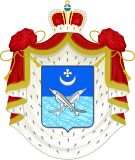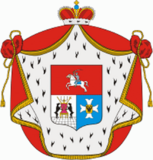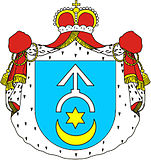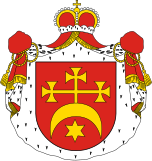Rurikids: Difference between revisions
Report bugs. | Suggested by Abductive | #UCB_webform 80/3850 |
Family life and children of Vladimir I#Overview, changed it to subsections with more meaningful names. |
||
| Line 148: | Line 148: | ||
There are currently various extant branches of the Rurikids, for instance: the Houses of [[Shakhovskoy]], [[Gagarin family|Gagarin]], and [[House of Lobanov-Rostovsky|Lobanov-Rostovsky]]. Whose some of the representatives are: Prince Dmitriy Mikhailovich Shakhovskoy (born 1934), [[Andrey Gagarin|Prince Dmitri Andreevich Gagarin]] (born 1973) and [[Nikita Lobanov|Prince Nikita Lobanov-Rostovsky]] (born 1935), a descendant of Prince Konstantin Vasilyevich of [[Principality of Rostov|Rostov]]. The three of them are of the [[Monomakhovichi]] branch.<ref>{{cite web|author=Manaev, G.|date=8 July 2019|title=Who founded Russia and ruled it before the Romanovs|url=https://www.rbth.com/history/330627-rurik-dynasty-founded-russia-ruled-before-romanovs|access-date=29 January 2020|publisher=Russia Beyond the Headlines}}</ref> While the Shakhovskoys claim descent from [[Mstislav I of Kiev]], the Gagarins, and the Lobanov-Rostovskys are descendants of [[Vsevolod the Big Nest|Vsevolod III of Vladimir]], which makes the Shakhovskoys the most senior. |
There are currently various extant branches of the Rurikids, for instance: the Houses of [[Shakhovskoy]], [[Gagarin family|Gagarin]], and [[House of Lobanov-Rostovsky|Lobanov-Rostovsky]]. Whose some of the representatives are: Prince Dmitriy Mikhailovich Shakhovskoy (born 1934), [[Andrey Gagarin|Prince Dmitri Andreevich Gagarin]] (born 1973) and [[Nikita Lobanov|Prince Nikita Lobanov-Rostovsky]] (born 1935), a descendant of Prince Konstantin Vasilyevich of [[Principality of Rostov|Rostov]]. The three of them are of the [[Monomakhovichi]] branch.<ref>{{cite web|author=Manaev, G.|date=8 July 2019|title=Who founded Russia and ruled it before the Romanovs|url=https://www.rbth.com/history/330627-rurik-dynasty-founded-russia-ruled-before-romanovs|access-date=29 January 2020|publisher=Russia Beyond the Headlines}}</ref> While the Shakhovskoys claim descent from [[Mstislav I of Kiev]], the Gagarins, and the Lobanov-Rostovskys are descendants of [[Vsevolod the Big Nest|Vsevolod III of Vladimir]], which makes the Shakhovskoys the most senior. |
||
==Branches== |
== Branches == |
||
{{Main|Grand Prince of Kiev|Grand Prince of Vladimir|List of rulers of Galicia and Volhynia|List of |
{{Main|Grand Prince of Kiev|Grand Prince of Vladimir|List of rulers of Galicia and Volhynia|List of leaders of Ukraine|List of Russian monarchs}} |
||
| ⚫ | |||
*[[Izyaslavichi of Polotsk]], princes of Polotsk |
*[[Izyaslavichi of Polotsk]], princes of Polotsk |
||
*[[Izyaslavichi of Turov]], princes of Turiv and Volhynia |
*[[Izyaslavichi of Turov]], princes of Turiv and Volhynia |
||
| Line 173: | Line 174: | ||
*Possibly the [[Wiśniowiecki]] family, a branch of the House of [[Zbaraski]] (extinct)<ref name="hd654">{{cite book|author1=Jerzy Jan Lerski|url=https://books.google.com/books?id=FPxhOu_n1VYC&q=Wisniowiecki&pg=PA654|title=Historical Dictionary of Poland, 966–1945|author2=Piotr Wróbel|author3=Richard J. Kozicki|publisher=[[Greenwood Publishing]]|year=1996|isbn=978-0-313-26007-0|page=654}}</ref> |
*Possibly the [[Wiśniowiecki]] family, a branch of the House of [[Zbaraski]] (extinct)<ref name="hd654">{{cite book|author1=Jerzy Jan Lerski|url=https://books.google.com/books?id=FPxhOu_n1VYC&q=Wisniowiecki&pg=PA654|title=Historical Dictionary of Poland, 966–1945|author2=Piotr Wróbel|author3=Richard J. Kozicki|publisher=[[Greenwood Publishing]]|year=1996|isbn=978-0-313-26007-0|page=654}}</ref> |
||
==Family tree |
=== Family tree of Russian monarchs === |
||
{{Main|Family tree of Russian monarchs}} |
{{Main|Family tree of Russian monarchs}} |
||
| ⚫ | |||
{{tree chart/start}} |
|||
{{tree chart}} <!-- modern family only --> |
|||
{{tree chart| | | | | | | | RUR |y| EFA | | RUR=[[Rurik]] | EFA=Efanda of Novgorod }} |
|||
{{tree chart| | | | | | | | | | |!| | | | | | | | | | | | | | | | | | }} |
|||
{{tree chart| | | | | | | | | | IGR |y| OLG | | | MAL | IGR=[[Igor of Kiev]] | OLG=[[Olga of Kiev]] | MAL=[[Malk Lubchanin]] }} |
|||
{{tree chart| | | | | | | | | | | | |!| | | |,|-|-|^|-|-|-|-|-|-|-|-|.}} |
|||
{{tree chart| | | | | | | | PRE |y| SVI |y| MAL | | | | | | ROV | | DOB | PRE=Predslava | SVI=[[Sviatoslav I of Kiev|Sviatoslav I]]| MAL=[[Malusha]] | ROV=[[Rogvolod]] | DOB=[[Dobrynya]] }} |
|||
{{tree chart| | | | |,|-|-|-|v|-|'| | | |`|-|-|-|-|-|.| | | |!| | | |!}} |
|||
{{tree chart| | | | OLE | | YAR |y| wife| | ANN |y| VLA |V| RON | | KON | OLE=[[Oleg of the Drevlyans|Oleg]] | YAR=[[Yaropolk I of Kiev|Yaropolk I]] | wife= ''Greek nun'' | ANN=[[Anna Porphyrogenita]] | VLA=[[Vladimir the Great|Vladimir I the Great]] | RON=[[Rogneda of Polotsk]] | KON=[[Konstantin Dobrynich]] }} |
|||
{{tree chart| | | | | | | | | | |!| | | | | | | |!| | | |:| | | | | |!}} |
|||
{{tree chart| | | | | | wife|~| SVI | | | | | | THE | | six | | | | DOB | wife=[[Bolesław I Chrobry|daughter of Bolesław I Chrobry]] | SVI=[[Sviatopolk I of Kiev|Sviatopolk I]] | THE=Theofana | six=[[Family life and children of Vladimir I|8 issues (see below)]] | DOB=Dobrynich line }} |
|||
{{tree chart| | | | | | | | | | | | | | | | | | |`|-|-|-|-|-|-|-|-|-|(}} |
|||
{{tree chart}} |
|||
{{tree chart/end}} |
|||
| ⚫ | |||
| ⚫ | |||
{{tree chart/start}} |
|||
{{tree chart}} <!-- modern family only --> |
|||
{{tree chart| OLO |y| EST | | | | | | | | | | | | | | | | | | | | | | | | | | ROG |y| VLA |y| ADE | OLO=[[Olof Skötkonung]] | EST=[[Estrid of the Obotrites]] | ROG=[[Rogneda of Polotsk]] | VLA=[[Vladimir the Great|Vladimir I the Great]] | ADE=Adela }} |
|||
{{tree chart| | | |!| | | |,|-|-|-|v|-|-|-|v|-|-|-|v|-|-|-|v|-|-|-|v|-|-|-|v|-|-|-|(| | | |)|-|-|-|v|~|~|~|V|~|~|~|7|}} |
|||
{{tree chart| | | ING |y| YAR | | IZY | | MST | | VSE | | PMI | | MTA | | PDS | | MCH | | BOR | | GLE | | STA | | SUD | ING=[[Ingegerd Olofsdotter of Sweden|Saint Anna]] | YAR=[[Yaroslav the Wise]] | IZY=[[Izyaslav of Polotsk]] | MST=Mstislav | VSE=Vsevolod | PMI=Premislava | MTA=Mstislava | PDS=Predslava | MCH=[[Mstislav of Chernigov]] | BOR=[[Boris and Gleb|Boris]] | GLE=[[Boris and Gleb|Gleb]] | STA=Stanislav | SUD=[[Sudislav]] }} |
|||
{{tree chart| | | | | |!| | | | | |!| | | | | | | | | | | | | | | | | | | | | | | |!|}} |
|||
{{tree chart| | | | | CHI | | | | POL | | | | | | | | | | | | | | | | | | | | | | EUS | | CHI=10 children | POL=Polotsk line | HN=[[Harald Hardrada|Harald III]] | AY=[[Anastasia of Kiev]] | AH=[[Andrew I of Hungary|Andrew I]] | AK=[[Anne of Kiev]] | HF=[[Henry I of France|Henry I]] | AG=[[Agatha, wife of Edward the Exile|Agatha]] | EE=[[Edward the Exile]] | EUS=Eustaphius }} |
|||
{{tree chart}} |
|||
{{tree chart/end}} |
|||
| ⚫ | |||
| ⚫ | |||
{{tree chart/start}} |
|||
{{tree chart}} <!-- modern family only --> |
|||
{{tree chart| | | | | | | | | OLA |y| VLA |y| MAL | OLA=Olava | VLA=[[Vladimir the Great|Vladimir I the Great]] | MAL=[[Malfrida]] }} |
|||
{{tree chart| | | | | | | | | | | |!| | | |!| | }} |
|||
{{tree chart| | | | | | | | | | | VYS | | SVI | | VYS=Vysheslav | SVI=Sviatoslav }} |
|||
{{tree chart}} |
|||
{{tree chart/end}} |
|||
==Wives and children of Vladimir I (3)== |
|||
{{tree chart/start}} |
|||
{{tree chart}} <!-- modern family only --> |
|||
{{tree chart| | | | | | | | | | | DOR |y| VLA |y| MIS | DOR=granddaughter of<br />[[Otto the Great|Otto I the Great]] | VLA=[[Vladimir the Great|Vladimir I the Great]] | MIS=unknown mistress}} |
|||
{{tree chart| | | | | |,|-|-|-|-|-|-|-|(| | | |!|}} |
|||
{{tree chart| CAS |~| MAR | | BER |~| OOW | | POZ| CAS=[[Casimir I the Restorer|Casimir I]]<br />duke of Poland | MAR=[[Maria Dobroniega of Kiev|Maria Dobroniega]] | BER=[[Bernard, Margrave of the Nordmark|Bernard]]<br />margrave of Nordmark | AGA=[[Agatha, wife of Edward the Exile|Agatha]] | OOW=out-of-wedlock<br />daughter | POZ=Pozvizd | EE=[[Edward the Exile]] }} |
|||
{{tree chart}} |
|||
{{tree chart/end}} |
|||
| ⚫ | |||
| ⚫ | |||
*[[Vladimir the Great]] |
*[[Vladimir the Great]] |
||
| Line 227: | Line 186: | ||
*[[Vsevolod I of Kiev]], son of Yaroslav the Wise |
*[[Vsevolod I of Kiev]], son of Yaroslav the Wise |
||
*[[Vladimir II Monomakh]], son of Vsevolod I of Kiev |
*[[Vladimir II Monomakh]], son of Vsevolod I of Kiev |
||
*[[Yuri Dolgorukiy|Yuri I Dolgorukiy]], |
*[[Yuri Dolgorukiy|Yuri I Dolgorukiy]], son of Vladimir II Monomakh |
||
The lineage from Yuri I onwards is given in the table below |
The lineage from Yuri I onwards is given in the table below |
||
===Family tree=== |
|||
[[File:Ruriks.jpg]] |
[[File:Ruriks.jpg]] |
||
Revision as of 17:07, 25 February 2023
This article should specify the language of its non-English content, using {{lang}}, {{transliteration}} for transliterated languages, and {{IPA}} for phonetic transcriptions, with an appropriate ISO 639 code. Wikipedia's multilingual support templates may also be used. (July 2019) |
The Rurik dynasty (
Following the disintegration of Kievan Rus', the most powerful state to eventually arise was the
The Romanovichi branch of the dynasty ruled southwestern Rus' and part of central Rus'. These territories were unified by
As a ruling dynasty, the Rurik dynasty held its own in some parts of Rus' for a total of twenty-one generations in male-line succession, from Rurik (died 879) to Feodor I of Russia (died 1598), a period of more than 700 years. They are one of Europe's oldest royal houses, with numerous existing cadet branches.
Origins
The Rurikid dynasty was founded in 862 by
According to the prevalent theory, the name Rus', like the Proto-Finnic name for Sweden (*Ruotsi), is derived from an Old Norse term for "the men who row" (rods-) as rowing was the main method of navigating the rivers of Eastern Europe, and that it could be linked to the Swedish coastal area of Roslagen (Rus-law) or Roden, as it was known in earlier times.[14][15]
The name Rus' would then have the same origin as the Finnish and Estonian names for Sweden: Ruotsi and Rootsi.[15][16]
The Primary Chronicle gives the following account of how the Rurik dynasty began, dating it to the Byzantine years of the world 6368–6370 (AD 860–862):[17]
The tributaries of the
Truvor, in Izborsk. On account of these Varangians, the district of Novgorod became known as the land of Rus'. The present inhabitants of Novgorod are descended from the Varangian race, but aforetime they were Slavs [преже бо бѣша Словѣни].
There is some ambiguity even in the Primary Chronicle about the specifics of the story, "hence their paradoxical statement 'the people of Novgorod are of Varangian stock, for formerly they were Slovenes.'" However, archaeological evidence such as "Frankish swords, a sword chape and a tortoiseshell brooch" in the area suggest that there was, in fact, a Scandinavian population during the tenth century at the latest.[18]
History

Rurik and his brothers founded a state that later historians called Kievan Rus′. By the middle of the twelfth century, Kievan Rus′ had dissolved into independent
Vsevolod's line eventually became better known as the Monomakhovichi and was the predominant one. The line of Sviatoslav later became known as Olegovychi and often laid claim to the lands of Chernihiv and Severia. The Izyaslavychi who ruled Turov and Volhynia were eventually replaced by a Monomakhovychi branch.

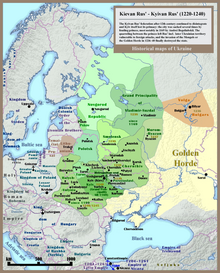
According to Jaroslav Pelenski,
The 'Riurikide' dynasty and the ruling elite ... attempted to impose on their highly diverse polity the integrative concept of russkaia zemlia ('the Rus' land') and the unifying notion of a 'Rus' people'. ... But 'Kievan Rus'' was never really a unified polity. It was a loosely bound, ill-defined, and heterogeneous conglomeration of lands and cities inhabited by tribes and population groups whose loyalties were primarily territorial.[20]
This caused the Rurik dynasty to effectively dissolve into several sub-dynasties ruling smaller states in the 10th and 11th centuries. These were the Olgoviches of
Descendants of Sviatoslav II of Kiev
The Olgoviches descended from
Descendants of Vsevolod I of Kiev
Vsevolod I of Kiev was the father of Vladimir II Monomakh, giving rise to the name Monomakh for his progeny. Two of Vladimir II's sons were Mstislav I of Kiev and Yuri Dolgorukiy.
The Romanoviches (Izyaslavichi of Volhynia) were the line of
The Rostislaviches were the line of Rostislav I of Kiev, another son of Mstislav I of Kiev, who was Prince of Smolensk and a progenitor of the lines descending from the princes of Smolensk and Yaroslavl.
The Shakhovskoys were founded by Konstantin "Shakh" Glebovich, Prince of Yaroslavl, and traces its lineage to Rostislav I of Kiev through his son Davyd Rostislavich. This branch also descends cognatically of Ivan I of Moscow, through the latter's daughter Evdokia Ivanovna Moskovskaya (1314–1342),[22][full citation needed] who married Vasili Mikhailovich, Prince of Yaroslavl (died 1345).[23] They were the great-grandparents of Andrey and Yuriy, the first Shakhovskoy princes. This is possibly the most senior extant branch of the Rurikids, with many Shakhovskoys living outside of Russia after having fled during the Russian Revolution.
The Yuryeviches were founded by
Vsevolod's son Yaroslav II of Vladimir was the father of Alexander Nevsky, whose son Daniel of Moscow sired the ruling house of Moscow until the end of the 16th century.
Beginning with the reign of
In that year,
Trade
In the early days of the Rurikid dynasty, the Kievan Rus' mainly traded with other tribes in
Skirmish with Byzantium
One of the largest military accomplishments of the Rurikid dynasty was the attack on Byzantium in 960. Pilgrims of the Rus' had been making the journey from
Legacy
Russian and Ukrainian historians have debated for many years about the legacy of the Rurikid dynasty. The Russian view sees the Principality of Moscow ruled by the Rurikid dynasty as the sole heir to the Kievan Rus' civilization, this view is "resting largely on religious-ecclesiastical and historical claims" because Russia was ruled by the Rurikid dynasty until 16th century, while Ukraine was not defined as a state until 20th century. This view started in Moscow as ruled by the original Rurikid dynasty between the 1330s and the late 1850s. The Ukrainian view was formulated much later, between the 1840s and the end of the 1930s in Eastern Austria, and views the Ukrainian descendants of the Rurikid dynasty as its only true successors. The Soviet theory was a modified version of the Russian which "allotted equal rights to the Kievan inheritance to the Three Slavic peoples, that is the Russians, the Ukrainians, and the Belorussians",[27] but later elevated the Russian nation as the elder brother to give the others "needed guidance in revolutionary struggles and socialist construction."[28]
There are currently various extant branches of the Rurikids, for instance: the Houses of
Branches
Family life and children of Vladimir I
- Izyaslavichi of Polotsk, princes of Polotsk
- Izyaslavichi of Turov, princes of Turiv and Volhynia
- Monomakhovichi, princes of Pereyaslav
- Izyaslavichi of Monomakh, princes of Volhynia, kings of Rus (senior branch)
- Rostislavichi, princes of Smolensk (middle branch)
- Yurievichi, princes of Vladimir-Suzdal, Grand Princes of Moscow (junior branch)
- Shakhovskoy, princes of Yaroslavl (senior extant branch)
- Lobanov-Rostovsky, princes of Rostov (middle extant branch)
- Gagarin, princes of Starodub-on-the-Klyazma (junior extant branch)
- Khilkov, princes of Starodub-on-the-Klyazma (junior extant branch)
- Mosalsky, princes of Mosalsky (Massalsky)
- Olgovichi, princes of Chernihiv
- Rostislavichi of Halych, princes of Halych
- Kropotkin, princes Kropotkin (extant)
- Rzhesvsky, non-titled (extant)
- Putyatin, princes Putyatin (extant)
- Obolensky, princes Obolensky (extant)
- Dolgorukov, princes Dolgorukov (extant; cadet branch of the Obolensky family)
- Gorchakov, princes Gorchakov (extant)
- Vadbosky, a branch of the princes Belozersky (extant)
- Volkonsky, a branch of the princes of Tarusa (extant)
- Possibly the Wiśniowiecki family, a branch of the House of Zbaraski (extinct)[30]
Family tree of Russian monarchs
Yurievich branch
The following shows the descent of the leading (historically most powerful) branch of the Russian Rurikids, being the descendants of Yuri I Dolgorukiy ("Long-Armed"), sixth son of Vladimir II Monomakh:
- Vladimir the Great
- Yaroslav the Wise, son of Vladimir I the Great
- Vsevolod I of Kiev, son of Yaroslav the Wise
- Vladimir II Monomakh, son of Vsevolod I of Kiev
- Yuri I Dolgorukiy, son of Vladimir II Monomakh
The lineage from Yuri I onwards is given in the table below

Gallery
-
Arms of the House ofHolstein-Gottorp-Romanov
-
Coat of arms of theDolgorukyfamily
-
Coat of arms of the Belosselsky-Belozersky family
-
Coat of arms of the Kropotkin family
-
KhilkoffCoat of arms
-
Coat of arms of theGolitsynfamily
-
Coat of arms of the Gorchakov family
-
Coat of arms of the Mosalsky family
-
Coat of arms of theOstrogskifamily
-
TheChernigov.
-
Coat of arms of the Romodanowski family
-
Coat of arms of theShuyskifamily
-
Coat of arms of theTatischevfamily
See also
References
- ^ Rurik Dynasty (medieval Russian rulers) Britannica Online Encyclopedia
- ^ Excerpted from Glenn E. Curtis, ed. (1998). "Russia: A Country Study: Kievan Rus' and Mongol Periods". Washington, D.C.: Federal Research Division of the Library of Congress. Archived from the original on 27 September 2007. Retrieved 20 July 2007.
- ASIN B004GV3YAM.
- ^ May, T. "Khanate of the Golden Horde". accd.edu. Archived from the original on 7 June 2008. Retrieved 27 December 2007.
- ^ "Rurik Dynasty Lays Claim to Kremlin". The Moscow Times. 16 June 2010. Retrieved 24 October 2022.
- doi:10.17223/18572685/36/8 (inactive 21 February 2023).)
{{cite journal}}: Cite journal requires|journal=(help)CS1 maint: DOI inactive as of February 2023 (link - ^ Wikidata Q105635025.
- ^ "Mykhaylo Hrushevsky | Ukrainian historian | Britannica". www.britannica.com. Retrieved 15 November 2021.
- Wikidata Q106528132.
- ^ "The Vikings at home". HistoryExtra. Retrieved 24 May 2020.
- ^ "Kievan Rus". World History Encyclopedia. Retrieved 24 May 2020.
- ^ "The Vikings (780–1100)". www.metmuseum.org. Retrieved 24 May 2020.
- ^ "Viking Tours Stockholm, 20 Historical Cultural Transported Tours". Sweden History Tours. Retrieved 24 May 2020.
- ISBN 9780521035521.
- ^ a b Stefan Brink, 'Who were the Vikings?', in The Viking World, ed. by Stefan Brink and Neil Price (Abingdon: Routledge, 2008), pp. 4–10 (pp. 6–7).
- ^ "Russ, adj. and n." OED Online, Oxford University Press, June 2018, www.oed.com/view/Entry/169069. Retrieved 12 January 2021.
- ^ The Russian Primary Chronicle, translated by Samuel Hazzard Cross and Olgerd Sherbowitz-Wetzor, pp. 59–60. For original, see here.
- ^ Franklin, Simon, and Jonathan Shepherd. The Emergence of Rus 750–1200. Harlow, Essex: Longman Group, Ltd., 1996. pp. 38–39.
- ISSN 2707-000X.
- ^ a b Pelenski, Jaroslaw. The Contest for the Legacy of Kievan Rus. New York: Columbia University Press, 1998. p. 4
- ^ Raffensperger, Christian, and Norman W. Ingham, "Rurik and the First Rurikids", The American Genealogist, 82 (2007), 1–13, 111–119.
- ^ Averyanov K. Principality of Moscow under Ivan Kalita (Accession of Koloman. Acquisition of Mozhaisk). – M., p. 36, 1994.
- ISBN 978-5-7429-0350-5.
- ^
"Родословная Екатерины II Великой, российской императрицы 1729–1796" [Ancestry of Catherine II the Great, Russian Empress 1729–1796]. Russia Today(in Russian). Retrieved 17 March 2022.
- ^ Franklin, Simon, and Jonathan Shepherd (1996). The Emergence of Rus 750–1200. Harlow, Essex: Longman Group, Ltd., pp. 27–28, 127.
- ^ Franklin, Simon, and Jonathan Shepherd (1996). The Emergence of Rus 750–1200. Harlow, Essex: Longman Group, Ltd. pp. 112–119
- ^ Pelenski, Jaroslaw Pelenski (1998). The Contest for the Legacy of Kievan Rus'. New York: Columbia University Press. p. 2.
- Wikidata Q106457257
- ^ Manaev, G. (8 July 2019). "Who founded Russia and ruled it before the Romanovs". Russia Beyond the Headlines. Retrieved 29 January 2020.
- ISBN 978-0-313-26007-0.




